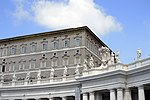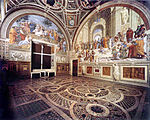Vatican Pharmacy

The Vatican Pharmacy (Latin and Italian: Farmacia Vaticana) is the only pharmacy in the Vatican City, founded in 1874 by Eusebio Ludvig Fronmen, a Fatebenefratelli religious. According to Vatican sources, it is the busiest pharmacy in the world, with 2,000 customers per day. Half of those customers come from outside the Vatican for medicines that are not available in Italy or are difficult to find.The current director of the pharmacy is Binish Thomas Mulackal, a Fatebenefratelli monk. Although the director of the pharmacy has always been a monk of that order, the staff pharmacists have been lay people for the past 30 years (7 religious and 53 laypeople in 2014). The pharmacy is organized under the Directorate of Health Services, one of eight Vatican City directorates.
Excerpt from the Wikipedia article Vatican Pharmacy (License: CC BY-SA 3.0, Authors, Images).Vatican Pharmacy
Post Street,
Geographical coordinates (GPS) Address Phone number Website External links Nearby Places Show on map
Geographical coordinates (GPS)
| Latitude | Longitude |
|---|---|
| N 41.904788888889 ° | E 12.456194444444 ° |
Address
Farmacia Vaticana
Post Street
00120 , Vatican City
Vatican City
Open on Google Maps







